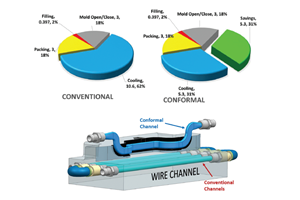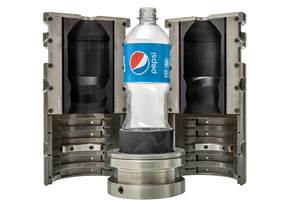Defining Rapid Manufacturing
A broad definition of rapid manufacturing is the use of software automation and connected manufacturing equipment to rapidly accelerate the manufacturing process. Read how one provider breaks down some of the considerations when applied to 3D printing.
Looking for some insight as to what rapid manufacturing really means, I connected with Protolabs.
How do you define rapid manufacturing?
A broad definition of rapid manufacturing is the use of software automation and connected manufacturing equipment to rapidly accelerate the manufacturing process. For moldmakers specifically, rapid manufacturing is on-demand, low-volume production of injection-molded plastic parts. However, rapid manufacturing encompasses more than just molding. This manufacturing automation is applied to 3D printing, CNC machining and more.
What can rapid manufacturing do for moldmakers and their customers?
Instead of waiting for weeks and months, and committing to a high capital expense, they can get an aluminum tool typically starting at a few thousand dollars that is capable of producing more than 10,000 parts—often tens of thousands of parts. The result is not only short-run parts in hand within a few days, but quality plastic and metal parts.
Automated design for manufacturability (DFM) analysis is another important benefit that software automation provides customers of rapid manufacturing. They can upload a CAD model online and have design feedback within 24 hours that identifies exactly what needs to be adjusted in the CAD model to improve it for manufacturability. This, in turn, reduces production issues and ultimately saves production dollars.
When enabled with a rapid manufacturer, a company can reduce product development cycles, reduce technical and supply chain risk and reduce the total cost of development and inventory.
When it comes to 3D printing, what are some guidelines for selecting the right material?
3D printing is unique. It is different from all other manufacturing processes, so the material properties and characteristics of parts that it produces are different, even when using a nearly identical alloy or thermoplastic. In terms of material properties, it is not a matter of being better or worse; it is simply important to recognize that the results will be different. Some processes such as stereolithography and PolyJet use photopolymer materials that mimic their thermoplastic equivalents, while others such as direct metal laser sintering and Multi Jet Fusion use commercial-grade metals and plastics, respectively. Again, look at material data sheets, and the part's application and function to determine your material. As an engineer would expect, materials and the manufacturing processes need to be validate for each application, and of course, this is most important for end-use applications.
What are some design tips for using both 3D printing and CNC machining for molds?
We always recommend milling molds out of aluminum or steel. You have more molding size options, as metal tooling handles the high heat of thermoplastic resin much better. Part quantities are limited to around 100 or so shots with printed molds (vs. thousands or hundreds of thousands with metal). Also, traditionally-manufactured mold features like ejector plates and pins are required for printed molds. Still, printed molds have their place, and some shops have had good success with them. Proponents argue that 3D printing produces molds up to 90 percent faster and 70 percent cheaper than using traditional moldmaking processes. And while this may be true in some circumstances, it’s important to understand the pros and cons of printed plastic molds compared to those machined from metal. Injection molds produced with 3D printing machines might be a viable alternative if:
- Very low quantities (10s) of relatively simple parts with large draft angles are needed.
- Your team is familiar with the design rules of molds made with 3D printing.
- People and machines are available to process and assemble the plastic tool.
What are some design tips that cross over injection molding to 3D printing to CNC machining?
Material selection, part geometry, and cosmetic requirements are three important considerations to look at for all three manufacturing processes. Even though 3D printing allows you to bypass many of the traditional design for manufacturing rules, if you plan to produce thousands of parts at some point in your production cycle, it is never a bad idea to start designing for manufacturability during 3D printing. That includes things like adding draft angles and radii on certain features, creating uniform wall thickness, and simplifying overly complex part design.
Related Content
3D Printing Innovates Hot Runner Manifold Design
Metal 3D printing combined with a conventionally machined manifold block overcomes flow shadows on valve gates and offers faster color changes while providing closer system pitch centerlines between cavities.
Read MoreHow to Use Thermal Management to Improve Mold Cooling
A review of common mold cooling issues and possible solutions, including 3D printing applications.
Read More3D Printing Enables Better Coolant Delivery in Milling Operations
Just like 3D printing enabled conformal cooling channels in molds, additive manufacturing is now being used to optimize coolant delivery in cutting tools.
Read MoreHow Hybrid Tooling Accelerates Product Development, Sustainability for PepsiCo
The consumer products giant used to wait weeks and spend thousands on each iteration of a prototype blow mold. Now, new blow molds are available in days and cost just a few hundred dollars.
Read MoreRead Next
How to Use Continuing Education to Remain Competitive in Moldmaking
Continued training helps moldmakers make tooling decisions and properly use the latest cutting tool to efficiently machine high-quality molds.
Read MoreReasons to Use Fiber Lasers for Mold Cleaning
Fiber lasers offer a simplicity, speed, control and portability, minimizing mold cleaning risks.
Read MoreHow to Use Strategic Planning Tools, Data to Manage the Human Side of Business
Q&A with Marion Wells, MMT EAB member and founder of Human Asset Management.
Read More












.jpg;maxWidth=300;quality=90)









